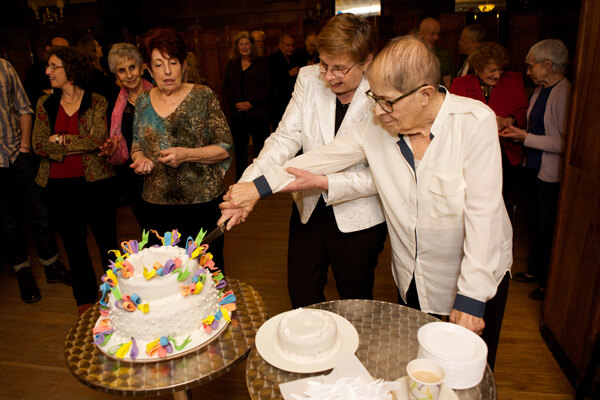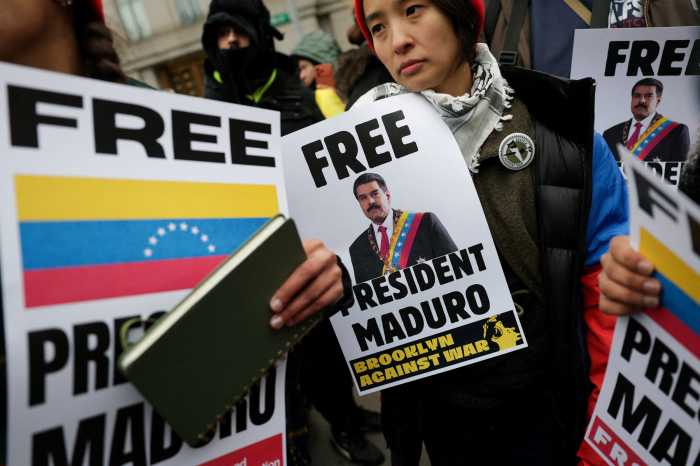In 2008, the plan to demolish the nine buildings that made up St. Vincent’s hospital in Greenwich Village and replace it with an $800 million condominium development ignited a firestorm of controversy throughout the city. The Catholic hospital that had served Lower Manhattan since 1849 was so much more than just a landmark. Particularly to those who had lived through the AIDS crisis, it was a rare, and often isolated, beacon of hope and place of compassion for a marginalized minority in a hostile — and terrifying — environment. Ultimately, it became a leading institution for AIDS research and treatment. That HIV is no longer an immediate death sentence is due, in part, to the triage St. Vincent’s provided and the contributions it made.
It wasn’t the first time the hospital and the nuns who ran it defied Catholic Church authority to provide care to the suffering. The hospital was founded in 1849 to serve the poor and largely Irish stricken by the cholera epidemic. Under the direction of Mother Elizabeth Ann Seton, the first American-born saint in the Catholic Church, the hospital served survivors of the Titanic, the Triangle Shirtwaist Factory Fire, and 9/11. Struggling financially almost since its inception, the loss of the hospital was nonetheless a devastating blow to many in the West Village — and forever changed its character.
The history of St. Vincent’s is the subject of a fascinating theater piece, “Novenas for a Lost Hospital,” running through October 13 at Rattlestick Playwrights Theater. It’s a mobile experience that begins in the garden of the adjacent St. John’s Church and ends at the AIDS memorial directly across from where St. Vincent’s had stood.
Written by Crusi Cram and gorgeously directed by Daniella Topol, this is profoundly moving political theater that is light on agitprop and heavy on human characters. For those who were here during the early days of the AIDS crisis, it is a deeply moving experience, recalling visits to Spellman 7, the AIDS floor, and the commixture of fear with moments of loving fun that grew in response to the terribly baffling crisis. But you don’t have to have been there to be profoundly moved and enlightened.
Ken Barnett, who plays several roles and has been deeply immersed in the play’s development, grew up in Memphis after the beginning of the AIDS crisis. He is part of the generation that came of age and became sexually active during the years between the initial diagnoses and the advent of effective treatments.
“All I knew was that I was probably gay — if I am gay, I will probably die of this disease,” he said.
Barnett turned to theater and plays such as “As Is” and “The Normal Heart” to help understand, but part of what he saw was “a grim chapter that was most likely ahead. Becoming sexually active during the AIDS crisis, we knew safe sex could keep you safe, and this play has invited me to look with fresh eyes at the AIDS crisis as a young gay man.”
Of the piece itself, Barnett added, “I appreciate how the play wakes up history for us in an interesting and dramatic way.”
In conveying that history, the play shows how resistance to medical advancement and hostile reactions toward people suffering from a misunderstood disease are nothing new.
“The care that people tried to give at St. Vincent’s and the care that people received there was committed and special,” Barnett explained. “At the same time, it complicated — these complex contradictions because of it being a Catholic institution. It went beyond treating a patient and not [simply] a medical chart. At the same time, they weren’t allowed to hand out condoms during the AIDS crisis.”
The contradictions had historical precedents. During the cholera epidemic, doctors at St. Vincent’s weren’t allowed to perform experiments on cadavers because that violated Church teaching. That there was a committed group of nuns willing to look the other way and bend the rules, even 150 years ago, saved many lives.
In “Novenas for a Lost Hospital,” Barnett plays both Lazarus, a young man dealing with his lover’s decline and death from AIDS, and Dr. Mott, the hospital’s lead doctor during the cholera epidemic. The time shifting amplifies the theme of humans needing to understand and help. The play does that, Barnett said, from “a gentle, feminine, almost Brechtian agitprop model. Led by Elizabeth Seton, a maternal figure so brilliantly embodied by Kathleen Chalfant, the play looks at the building and asks, ‘How did this happen?’”
Barnett pointed out that the same questions we ask today about culture and community were what Seton was asking.
“What will we do in this terrifying modern time?,” Barnett explained. “When every time we look at our phone there’s something new. What are we doing to care for each other? A famous epicenter of care can evaporate before our eyes and become luxury condos.”
Like the best political theater, “Novenas for a Lost Hospital” persuades by touching one’s heart. Standing under the AIDS memorial on a warm, late-summer evening, one could almost feel the ghost of Elizabeth Seton and the thousands of patients who gave their lives so that we could have the treatments we have today. And it raises the ultimate question of political theater: Now, what will you do?
NOVENAS FOR A LOST HOSPITAL | Rattlestick Playwrights Theater, 224 Waverly Pl. at W. 11th St. | Through Oct. 13:Mon., Wed.-Sun. at 7 p.m.; Fri. at 1 p.m. | $61 at ovationtix.com or 212-627-2556 | Two hrs., 30 mins., no intermission




































